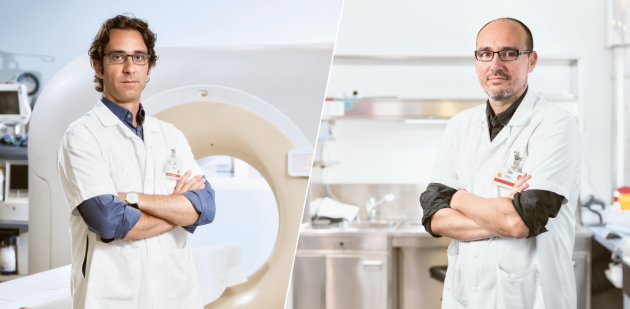Patrick Omoumi and Igor Letovanec are responsible for a crucial step in patient care at the Sarcoma Centre at CHUV: diagnosis.

Sarcomas are rare tumours that develop in different types of tissue, including bones, muscles, tendons and other soft and connective tissue. With more than 160 types of tumours that can develop anywhere in the body and at varying growth rates, these cancers can be a real nightmare for doctors to identify. “Patients with this form of cancer require treatment in a specialised care facility as soon as it’s detected,” says Patrick Omoumi, the physician responsible for musculoskeletal imaging at Lausanne University Hospital (CHUV) for the past three years. Radiologists are in charge of the particularly sensitive step of taking images of the tumour and performing the biopsy. “When we suspect a sarcoma, we have to remove a sample of the tumour for analysis according to a very specific procedure to prevent the tumour from spreading and to achieve the best possible outcome for the patient, working with the surgeon who will take over from there.”
After the biopsy is when pathological analysis comes in. “With the advances in biopsy techniques, we can now reach almost any tumour,” says the pathologist Igor Letovanec, specialised in musculoskeletal and thoracic diseases. “But the samples are much smaller. That makes the procedure less painful for the patient, but the pathologist’s work becomes more complex. Imagine you have to identify a painting by only looking at an ever smaller part of it. That’s where radiology can bring additional insight. If we don’t work with imaging data and talk about bone tumours with the radiologist, it could lead to an error.”
“Patients with this form of cancer require treatment in a specialised care facility as soon as it’s detected”
Each patient case at the Sarcoma Centre is reviewed at a weekly meeting. “You might say that a part of diagnosis is based on the radio-logist’s macroscopic view and the pathologist’s microscopic view,” says Patrick Omoumi. “Oncologists and surgeons can then combine our views to decide on the best therapy. Experience is vital with this type of disease. That’s why we came together as a specialised care centre at CHUV, where more than 52% of the patients we care for come from another canton,” he says. “However, in the very rare cases when we’re still not sure, we send the radiological images and histological sections to Massachusetts General Hospital in Boston, one of the world’s leading sarcoma research centres, to be as sure as we can be of getting the diagnosis right.”
Once the diagnosis is made, the surgeon takes over – as surgery is the only effective treatment for sarcoma – along with the oncologist to care for the patient. In 2015, the Sarcoma Centre cared for 80 new patients, including nine children, with a survival rate after one year of 95%. ⁄